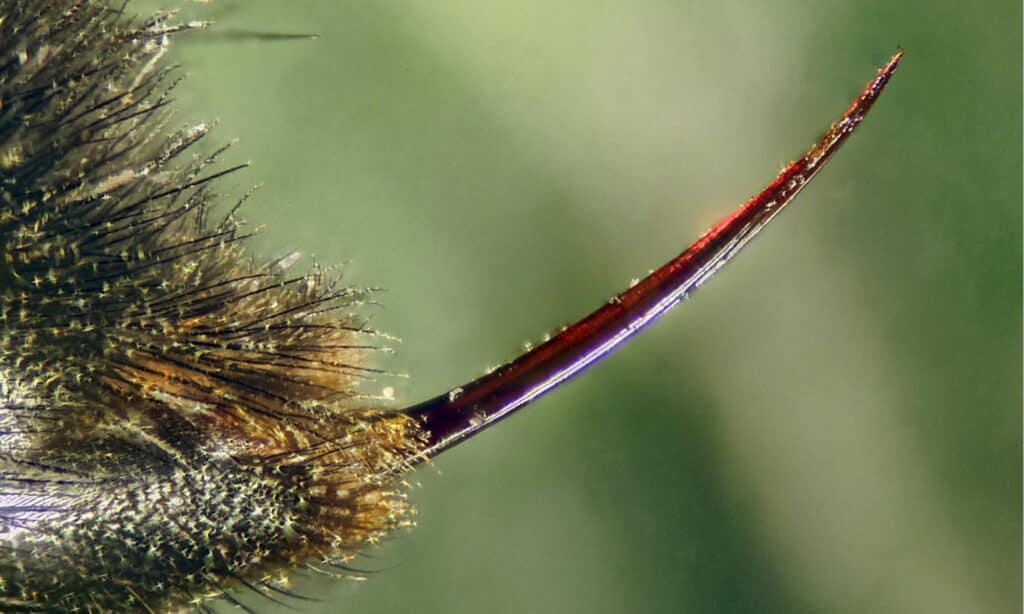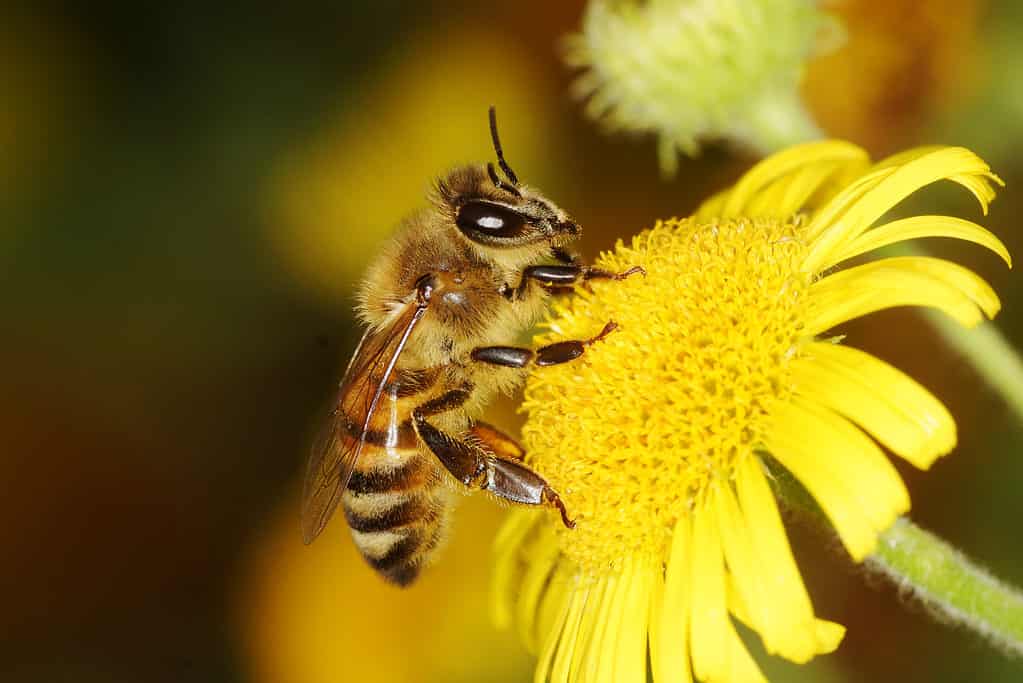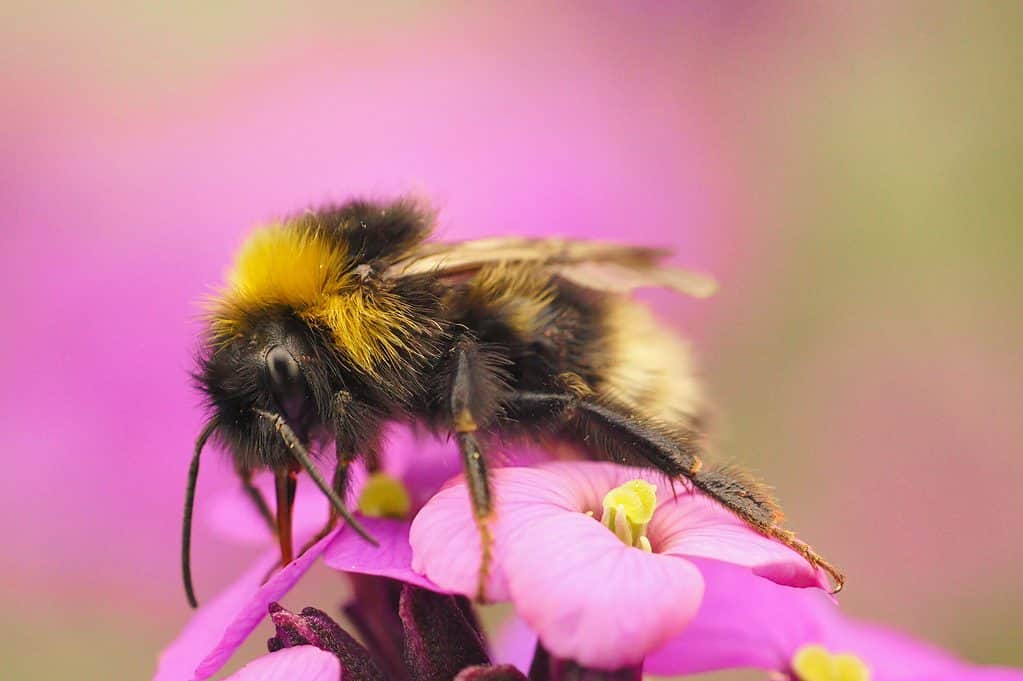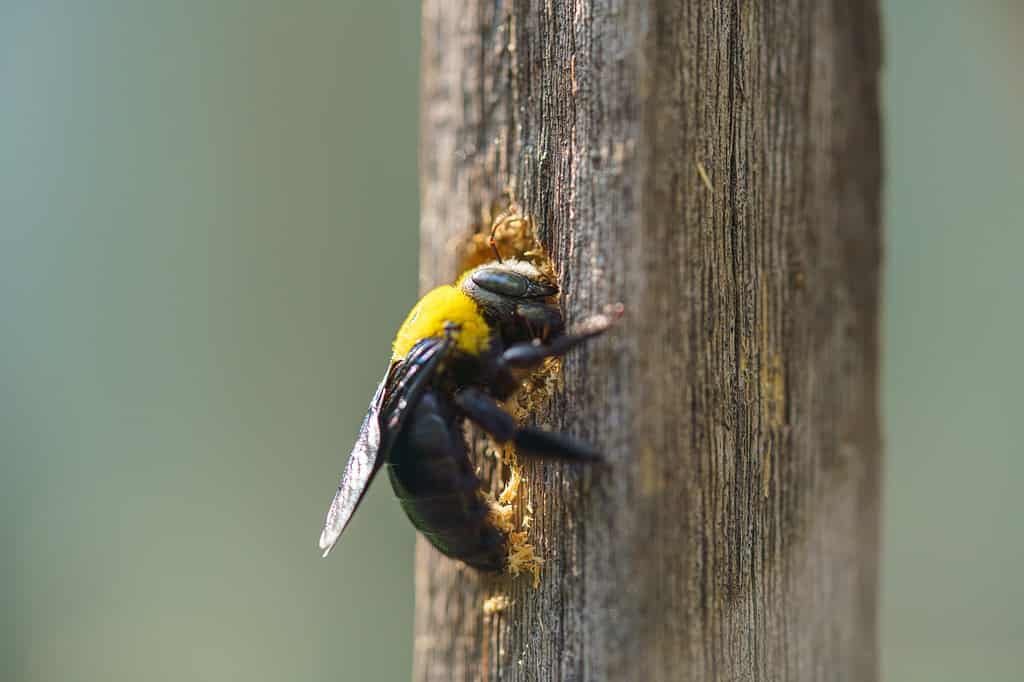As pollinators of 75 percent of flowering plants and soil-builders, bees play a crucial role in both natural and agricultural ecosystems. Pollinators are essential for plant reproduction and fruiting. In Arizona, you can find 1,300 different natural ground-nesting, twig-nesting, and parasitic bee species.
Many species of social bees are found in Arizona, and these bees will defend their hives by using their venom. Insect stings hurt, but there are some that hurt much more than others. Naturally, this calls for a ‘sting pain’ index to explain the aftermath of coming face to face with a stinger. Believe it or not, there is a scale for this!
Evaluating the Pain Index of Bee Stings

Bumblebee
stinger up close: The Schmidt Pain Index rates insect stings from 0 (harmless) to 4 (like hot lava on your skin).
©Frank Reiser/Shutterstock.com
An entomologist by the name of Justin O. Schmidt studied the painfulness of stings from 78 insect species in 2019; 18 of these were bees. The study includes enough bees from a variety of genera (bee types) to raise reasonable suspicions that the data paint a fair picture of the discomfort caused by bee stings.
The pain from a sting is measured using the Schmidt Pain Index, which ranges from 0 (totally harmless) to 4 (like molten lava on your skin). This guide gives information for identifying four bees commonly observed in Arizona, ranked by most painful sting based on the Schmidt scale.
Most Painful Bee Stings in Arizona

There are around 1,300 species of native bees in Arizona.
©Harry Beugelink/Shutterstock.com
Before we begin it is important to note that none of the bees on the Schmidt scale surpass a pain level of 2.5. Below we have categorized the main bees found in Arizona based on their stinger pain level. We will start with level 1 bees and work our way up. We will also explore some general information about each bee, including what they look like. Let’s go!
Schmidt Pain Index: Level 1 Bees
According to Schmidt, the effects of a level 1 bee sting are minimal at best. He likened the pain to having a single hair on your arm singed by a tiny spark. Not the worst thing ever, but still bad enough to get a reaction!
Sweat Bee

The Schmidt Pain Index ranks the sting from a sweat bee, one of the bees found in Arizona, as the lowest of any stinging insect.
©Barbara Storms/Shutterstock.com
Several species of the family Halictidae are referred to here as “sweat bees” because of their propensity to be drawn to human sweat. Their small tongues are well-suited for sucking up human perspiration. Only when rubbed against the skin will this bee strike and the sting from a sweat bee is the least painful of any stinging insect, according to the Schmidt Pain Index. They do not have actual stingers, and the reaction to their venom is mild. Symptoms generally include itching with mild redness and swelling at the site.
In the world of bees, sweat bees stand out for their metallic, lustrous, and bright lime-green coloring. Many of them are all green, but others have a green head and a yellow/black body pattern. There are hundreds of tiny prickly hairs all throughout a bee’s body.
Schmidt Pain Index: Level 2 Bees
Schmidt compares the pain of a level 2 bee stung to that of having a cigar put out on one’s tongue or smashing one’s hand in a revolving door. Ouch!
Honey Bee

Honey bees may sting if they feel threatened or if they need to defend their colony.
©Maciej Olszewski/Shutterstock.com
The Apis genus of the bee family includes the eusocial honey bee (sometimes called honeybee), which is endemic to the continents of Africa and Eurasia. Typically, roughly 15 mm in length, honey bees are often golden or yellow in color with brown stripes and have an oval body shape. Honey bees have a wide range of body colors, from mostly black in some species to changing dark-to-light striations in others.
Honey bees, one of the types of bees found in Arizona, will often sting in self-defense or to protect their colony. The stinger is a barbed needle that protrudes from the creature’s abdomen. It, like the venom sac, is connected to the bee’s digestive system. A honeybee’s sting leaves behind more than just its stinger; it also leaves behind digestive tissue, muscle, and nerves. The bee eventually dies from an internal hemorrhage.
If stung, you may experience a burning pain at the site for up to two hours. The typical venom swelling might last for up to 48 hours following the attack as well. However, swelling may persist for up to a week.
American Bumblebee

Bumblebees, unlike honeybees, are much less aggressive and will only sting once, if at all.
©HWall/Shutterstock.com
Bombus pensylvanicus or bumble bees are between 16 and 25 mm in length, depending on the type. Legs, spurs, and tegulae (the base of the wings) are all black on the queen. Queens are the largest of the colony and commonly have a yellow spot in the middle of the most anterior part of their backs.
The face of a worker bee is long, the middle of its back is yellow, and the tail is black. The hair on top of the head is uniformly black and short. The males are distinguished by their yellow bellies, black heads, and black thoracic stripes.
Although bumblebees can sting more than once, they are significantly less likely to do so than honeybees. Non-allergic local reactions, such as swelling, itching, and redness at the sting site, often last only a few hours after. Sometimes this happens directly following the sting, but more often it takes a while. The redness or itching could last for several hours up to several days.
Schmidt Pain Index: Level 2.5
Schmidt has defined the range of symptoms for level 2.5 bee stings as falling among that of levels 2 (described above) and 3. Level 3 has been compared to someone using a drill to remove an ingrown toenail from your foot, while others have compared it to pouring acid on a paper cut. Neither sounds pleasant!
Giant Carpenter Bee

Pain and burning, both at the sting site and in the surrounding skin, characterize carpenter bee stings.
©media-ja/Shutterstock.com
Carpenter bees are bees found in Arizona. Because nearly all species of this bee type construct their nests in decaying wood or bamboo, the term “carpenter bee” is used to describe them. These are the largest among all native bee species in the United States.
Carpenter bees, or Xylocopa, are small insects that can be black, metallic blue, purplish blue, or greenish black. They have been likened to bumble bees due to their size and resemblance to their color. The abdomen of a female carpenter bee is smooth, black, and hairless. They have thick hairs on their legs which are used to collect pollen. Depending on the species, the males might be either black or golden. Yellow spots on the face are common among males.
Unless you handle female carpenter bees or poke your fingers into their tunnels (which you should not do), you probably won’t get stung by one. Carpenter bee males don’t have stingers since they’re not necessary for their survival. Carpenter bees retain their stinger after an assault, so you won’t need to worry about getting a stinger out of your skin.
Bee venom can be found in the stingers of female carpenter bees. Carpenter bee stings cause severe pain and a burning sensation at the sting site and in the surrounding skin. It may leave a red, swelling welt that throbs for a few days. For some who are hypersensitive to bee venom, a sting at this level can be extremely painful and even fatal.
In Conclusion
It is clear from this page that most of the bees mentioned here have a relatively mild to moderate sting, with honey bees and bumble bees falling somewhere in the center. Not all bees sting, and most bees aren’t aggressive, so that’s something to keep in mind as well. Those that sting usually only do so in response to an actual or perceived threat. As a result, it is essential that you do not approach a bee colony or its hive.
Thank you for reading! Have some feedback for us? Contact the AZ Animals editorial team.








